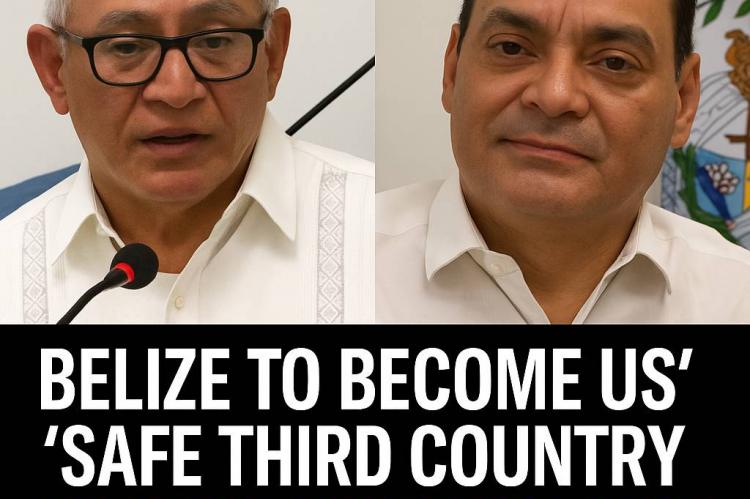**A Nation Overburdened, A Government Overreaching:
Can Belize Afford the U.S. Safe Third Country Deal & CARICOM Free Movement? **
By Omar Silva, Editor/Publisher
National Perspective Belize, Editorial Desk
Belize City: Sunday 19th October 2025
The Briceño Administration is charging forward with decisions that could alter the very fabric of Belizean society—and not for the better. The announcement by Foreign Minister Francis Fonseca that Belize is finalizing a Safe Third Country agreement with the United States, coupled with the hasty rollout of CARICOM Free Movement, has sent shockwaves through an already fragile nation.
With rising poverty, broken promises, and critical shortages in healthcare, housing, and education, the question must now be asked: Can Belize really afford to carry the burdens of others while its own citizens suffer?
🇺🇸 Safe Third Country Deal: Who Benefits?
At the start of 2025, Prime Minister John Briceño had publicly rejected the idea of Belize taking in rejected asylum seekers from the U.S. But in a dramatic reversal, his government is now preparing to sign on—with "safeguards," we are told.
Minister Fonseca outlined terms such as a cap on annual transferees, veto power over who enters, and a 2-year renewable clause. But behind the legalese lies a cold truth:
🔥 Belize is agreeing to become a migrant buffer zone for the United States—absorbing human fallout from a global asylum crisis we did not create and cannot manage.
Fonseca says the deal includes "financial and technical assistance"—but how many times have Belizeans been promised "support" that never materialized beyond a press release?
🌍 CARICOM Free Movement: A Noble Ideal, A Harsh Reality
Simultaneously, Belize has opened its borders to nationals from Barbados, Dominica, and St. Vincent and the Grenadines, allowing them to live and work indefinitely.
On paper, regional integration is a noble pursuit. But in practice, this "free movement" will inject new pressures into a country already buckling under the weight of its own socio-economic crisis.
Where will the jobs come from?
Where will they live?
Can our schools and hospitals handle the influx?
Government claims "monitoring mechanisms" and a new "indefinite stay stamp" are in place, yet public awareness is virtually non-existent, and no data has been shared about projected arrivals or their potential impact.
🏚️ Housing, Health & Hunger: Belizeans Still Wait
Meanwhile, thousands of Belizeans still rent their homes—never having owned a piece of land or a house. The housing revolution promised in "Plan Belize 2.0" has been reduced to a handful of cramped one-bedroom boxes, handed out by ministers to politically loyal single mothers.
In hospitals, patients are given prescriptions for medicines that the public system cannot supply—forced to beg neighbors and relatives to afford basic pharmaceuticals. The Karl Heusner Memorial Hospital and regional hospitals in the North, South, and West routinely run out of essential supplies.
The long-promised University Teaching Hospital—touted as a symbol of tertiary health care and medical education—has disappeared from public discourse altogether. Another illusion. Another campaign gimmick.
📉 The Broken Promises of 2025
The PUP won the March 2025 general election under constitutionally questionable circumstances—with redistricting still before the courts and the opposition UDP internally fractured and financially deflated.
They promised:
- A $6.00 minimum wage (still not implemented),
- Lower cost of living (now higher than ever),
- Thousands of homes and land grants to first-time Belizean families (undelivered),
- And a modern university hospital that was never built.
But what has the Belizean people received in return?
Today, the cost of basic groceries, fruits, and vegetables has more than tripled.
📈 What cost $40 in 2020 now costs $150 or more in 2025.
The government’s empty boasts of economic recovery and “people-cantered development” are crushed under the weight of these rising prices.
Electricity rates, water bills, and butane prices are sky-high, while wages remain stagnant, and inflation eats away at the purchasing power of Belizean families.
Even the few hundred low-cost houses built under “Plan Belize 2.0” are being distributed selectively, mainly to single mothers handpicked by ministers, rather than through fair or transparent mechanisms.
Yet here we are—opening our borders to asylum seekers from the U.S. and embracing regional labour migration while our own people are jobless, landless, homeless, and hungry.
⚖️ Who Will Carry This Burden?
The Briceño-Fonseca agenda is increasingly being seen as tone-deaf to the cries of Belizeans and dangerously aligned with external interests rather than national priorities.
Belize is a nation of fewer than half a million people, still grappling with post-COVID recovery, chronic underemployment, and fragile institutions. And yet, the government now proposes to act as a migrant host, a refugee processor, and a regional labour magnet—with no public debate, no cost-benefit analysis, and no infrastructure in place.
❗ This is not leadership. This is recklessness.
🗣️ We Must Ask: Who Speaks for the Belizean People?
We cannot accept asylum seekers while Belizeans are sleeping in overcrowded rentals, begging for medicine, and dropping out of school for lack of funds.
We cannot welcome CARICOM workers while our own youth roam the streets jobless graduates with degrees but no opportunities.
And we certainly cannot allow foreign powers to dictate our immigration and energy policies while Belizeans struggle to buy rice, pay electricity, and survive.
🔚 Final Word
The Briceno Administration’s double gamble—signing the U.S. Safe Third Country deal and accelerating CARICOM Free Movement—amounts to an assault on the poor, the voiceless, and the forgotten Belizean.
“Before we carry the burdens of the world, we must first lift the burdens of our own people.”
Let the debate begin.
- Log in to post comments

